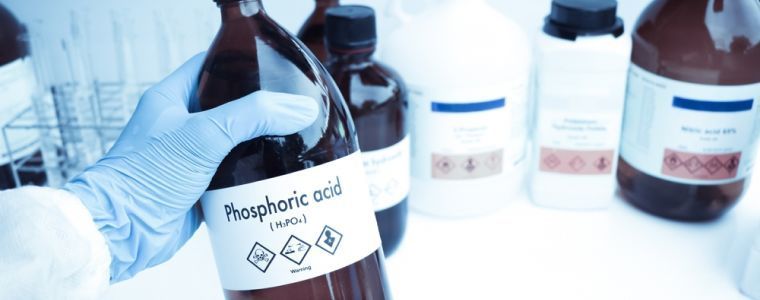Tributyl Phosphate (TBP): Properties, Uses and Safety Considerations
Tributyl phosphate (TBP) is an organic compound widely used across multiple industries for its chemical versatility. It’s a colorless, odorless liquid, classified as a phosphate ester and commonly employed as a solvent and plasticizer. TBP is synthesized through the reaction of phosphoric acid with butanol, resulting in a compound with properties that make it essential in industrial applications such as nuclear processing, plastic manufacturing and flame retardants.
What is Tributyl Phosphate?
Tributyl Phosphate (C12H27O4P) is a polar molecule with a broad range of industrial applications due to its chemical composition. It acts as an effective solvent, extractant and plasticizer. The structure of TBP consists of a phosphate group attached to three butyl chains, which provides it with desirable properties in terms of solubility and interaction with other substances.
Some of the key properties of TBP include:
- Solubility: Soluble in organic solvents but insoluble in water.
- Physical Properties:
- Appearance: Colorless, oily liquid
- Odor: Faint odor
- Boiling Point: 289°C
- Density: 0.976 g/mL
TBP’s ability to dissolve a wide range of substances makes it an ideal solvent in industrial processes like metal extraction and nuclear fuel processing. Its plasticizing ability improves flexibility and durability in plastics, while it also functions effectively as a flame retardant in various materials.
Key Applications of Tributyl Phosphate
Tributyl Phosphate’s chemical properties make it valuable across different industries. Below are some of the most common applications of TBP:
Solvent for Metals and Salts
Tributyl Phosphate is highly effective as a solvent in liquid-liquid extraction processes. One of its most critical uses is in the nuclear industry, where it serves as a primary solvent for separating uranium and plutonium in reprocessing nuclear fuels. Its ability to extract these metals from aqueous solutions ensures that TBP plays an essential role in the nuclear sector.
Plasticizer for PVC and Other Polymers
In the plastics industry, TBP is often employed as a plasticizer, particularly for polyvinyl chloride (PVC). It enhances the flexibility, durability and processability of PVC and other polymers, making it a key additive in products like flooring, pipes, and packaging materials.
Flame Retardant
Tributyl Phosphate is also widely used as a flame retardant. It’s incorporated into hydraulic fluids, rubber and plastics to reduce the flammability of these materials. This property makes it essential for enhancing the safety of industrial products that require resistance to heat and fire, such as building materials and electronic components.
Tributyl Phosphate Toxicity and Health Effects
While TBP is versatile, it is also a compound that requires careful handling due to its potential health risks. Prolonged or excessive exposure to TBP can lead to various health issues, which include skin irritation, respiratory problems, and potential liver and kidney damage.
Health Risks from Tributyl Phosphate Exposure
Acute exposure to Tributyl Phosphate can result in skin and eye irritation, as well as respiratory discomfort when inhaled. Chronic exposure, especially in industrial environments, may cause more severe effects on the liver, kidneys and nervous system. TBP can enter the body through inhalation, skin contact, or ingestion, necessitating the use of protective measures when handling it.
Occupational Safety and Hazard Management
To mitigate the health risks associated with TBP, it is critical to implement stringent industrial hygiene practices. Workers handling TBP should wear appropriate personal protective equipment (PPE), including gloves, protective clothing and respiratory protection. Proper ventilation and regular air monitoring in work environments are also essential to reduce the risk of exposure.
Environmental Impact of Tributyl Phosphate
Tributyl Phosphate can pose significant environmental challenges due to its persistence in soil and water. As a potential environmental pollutant, TBP can accumulate in ecosystems, particularly aquatic environments, leading to harmful effects on marine life and plants.
Tributyl Phosphate has been found to have toxic effects on aquatic organisms, including fish and algae. Its release into water bodies through industrial waste or improper disposal can result in long-term environmental damage. To prevent these risks, regulatory bodies have implemented guidelines to control the discharge and disposal of TBP-containing waste.
Safety Guidelines for Handling Tributyl Phosphate
Strict safety protocols are necessary when working with Tributyl Phosphate to minimize both health and environmental risks. Below are some key safety measures:
Recommended PPE for Workers
- Gloves: Workers should wear chemically resistant gloves, such as nitrile or butyl rubber, to prevent skin contact.
- Protective Clothing: Lab coats, long sleeves, and face shields are necessary to avoid skin and eye exposure.
- Respiratory Protection: Adequate ventilation or the use of respirators is required when working in poorly ventilated areas or handling large quantities of TBP.
Proper Storage and Disposal Practices
Tributyl Phosphate should be stored in tightly sealed containers in well-ventilated areas. The storage environment should be cool and away from heat sources to prevent decomposition and the release of harmful fumes. Disposal of TBP must comply with local environmental regulations, which often require the compound to be treated as hazardous waste.
Alternatives to Tributyl Phosphate in Industry
Given the potential health and environmental risks of Tributyl Phosphate, many industries are exploring safer alternatives. One promising substitute is phosphate ester variants with reduced toxicity profiles. Green chemistry solutions, including bio-based solvents, are also being developed to minimize the use of hazardous chemicals while maintaining similar performance characteristics.
These alternatives may provide a safer and more sustainable option, particularly for industries that prioritize reducing their environmental footprint.
Conclusion
Tributyl Phosphate (TBP) is a critical compound in various industrial processes, particularly in nuclear fuel reprocessing, plastic manufacturing and as a flame retardant. While its chemical properties make it highly valuable, TBP also presents health and environmental risks that necessitate careful handling and adherence to safety guidelines.
As industries strive to balance efficiency with safety, exploring alternative chemicals and methods may be the key to reducing reliance on TBP while continuing to achieve high performance in manufacturing and industrial processes.
















